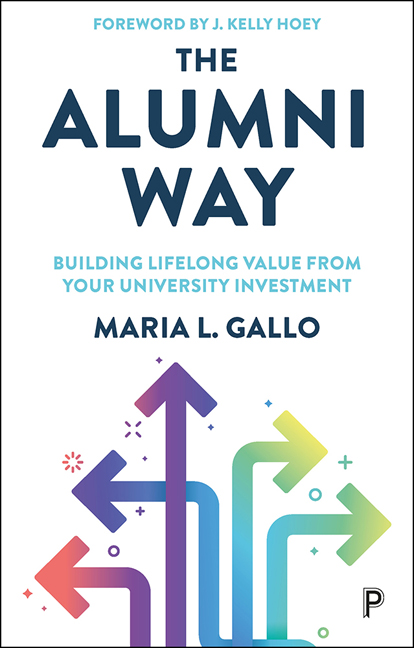Book contents
- Frontmatter
- Dedication
- Contents
- Acknowledgements
- Foreword
- Introduction: We are all alumni
- PART I Charting the course of the Alumni Way
- PART II The Alumni Way trait: Reflection
- PART III The Alumni Way trait: Curiosity
- PART IV The Alumni Way trait: Passion
- PART V The Alumni Way trait: Generosity
- PART VI Alumni: Bringing it into our lives
- Notes
- References
- About the author
- Index
2 - The compass: Introducing alumni capital
Published online by Cambridge University Press: 13 May 2022
- Frontmatter
- Dedication
- Contents
- Acknowledgements
- Foreword
- Introduction: We are all alumni
- PART I Charting the course of the Alumni Way
- PART II The Alumni Way trait: Reflection
- PART III The Alumni Way trait: Curiosity
- PART IV The Alumni Way trait: Passion
- PART V The Alumni Way trait: Generosity
- PART VI Alumni: Bringing it into our lives
- Notes
- References
- About the author
- Index
Summary
Alumni capital is a powerful resource to help us achieve the life we want. Set aside those graduation books: alumni capital is extraordinary advice to graduates. Our alma mater is a hypernetwork at our disposal: a multitude of connections. By following the Alumni Way, these connections will emerge during the process, steering us and acting as our compass.
We have excellent reasons to keep in touch with our alma mater, for years and even decades after graduation. Alumni capital is a form of social capital. We can profit from our alumni social capital by connecting with the networks that share our values. As with social capital, we can invest in our alumni capital and expect a reasonable return on our investment.
The bonding and bridging components of social capital are also present in alumni capital. Robert Putnam, in his book Bowling Alone, explains: ‘Bonding social capital constitutes a kind of sociological superglue, whereas bridging social capital provides a sociological WD-40.’ In an alumni context, it's easy to find a cohesive, bonding experience, say with a group of former classmates at an alumni reunion. The diversity in an alumni network can also be a flexible lubricant, a bridge, such as an alumni mentorship programme for current students. The bonding and bridging alumni capital is fluid, it happens at the same time across a multitude of groups, even on an intergenerational basis. Our alumni community is an inclusive one: every graduate has alumni capital, as does every student, university administrator, professor, and career adviser.
This alumni capital also allows for the democratization of our networks, a linking capital. These links help to extend the boundaries of our traditional network with alumni across the globe in different sectors and with different interests. History graduates are connected to engineers and business majors, who are connected to football players, debaters, and cooking enthusiasts, who are connected to alumni in Atlanta, Amsterdam, and Australia. This interconnectivity all by virtue of a shared alma mater.
The cynics in us might be thinking: I’ve connected with friends, former classmates, and acquaintances on social media. Why hasn't it had the transformational effect of alumni capital described here?
Information
- Type
- Chapter
- Information
- The Alumni WayBuilding Lifelong Value from your University Investment, pp. 15 - 24Publisher: Bristol University PressPrint publication year: 2021
